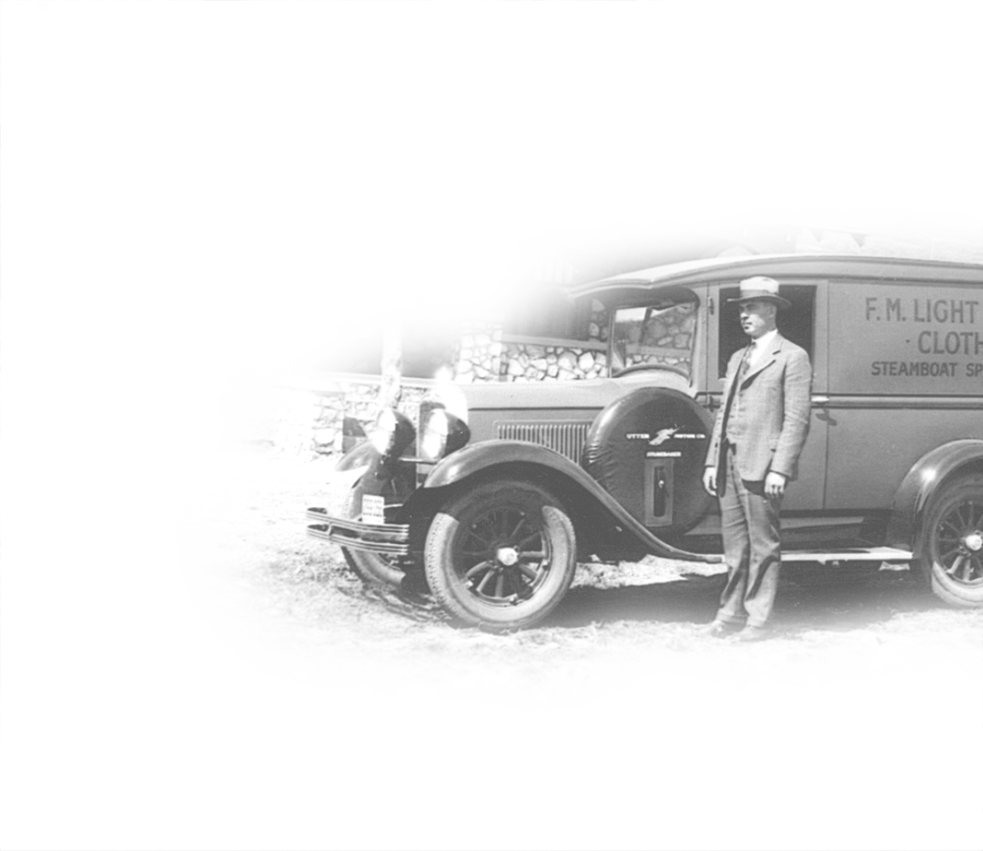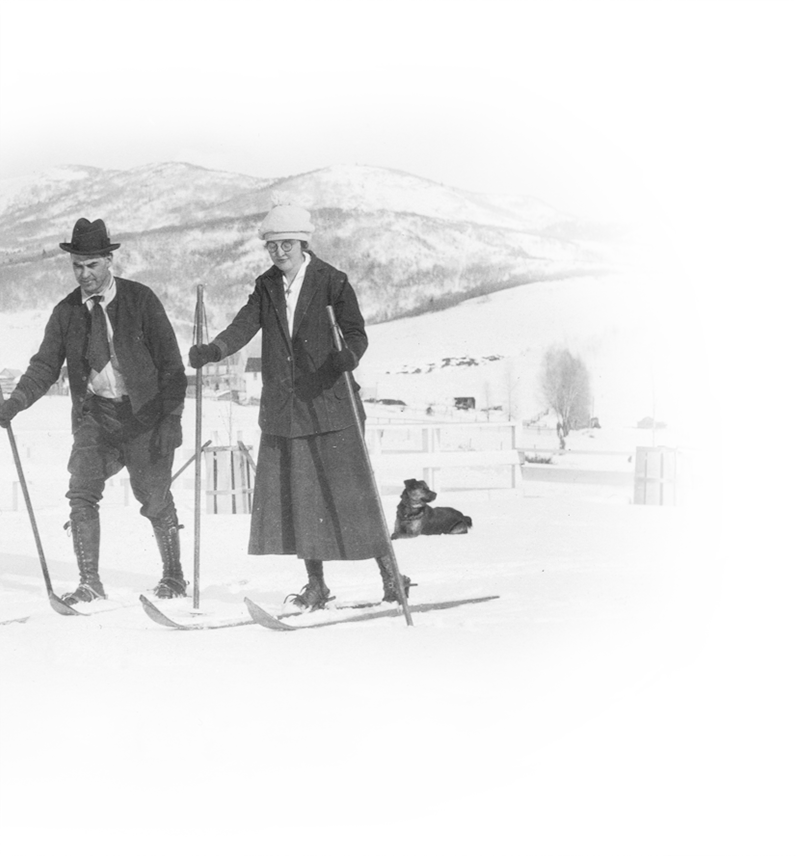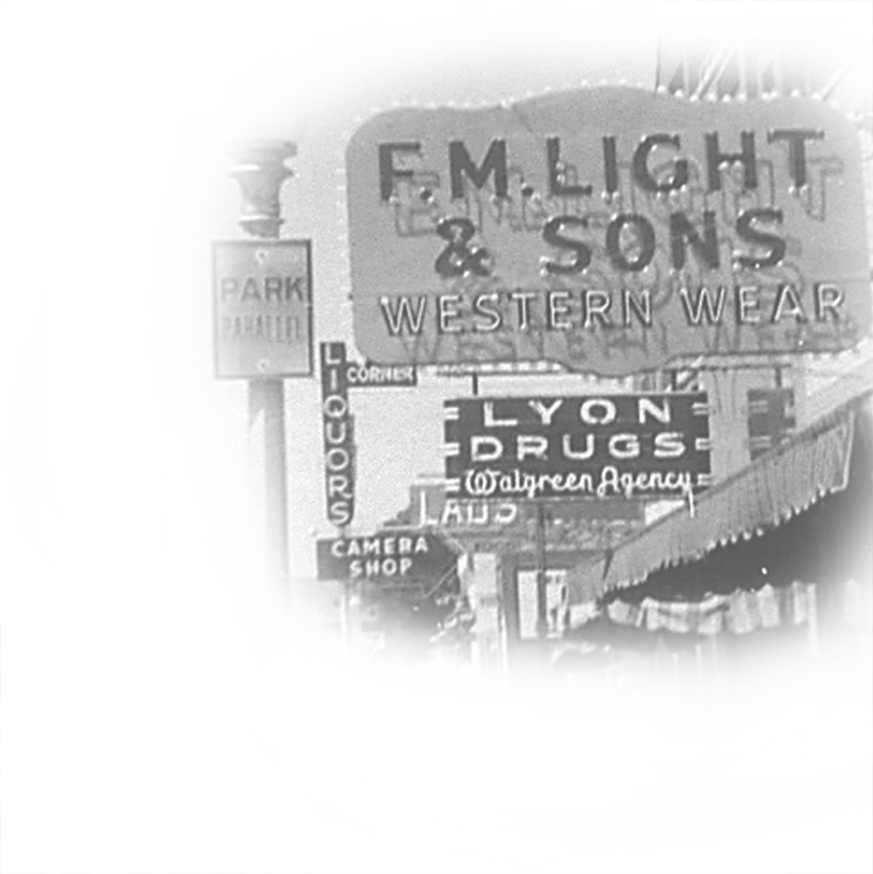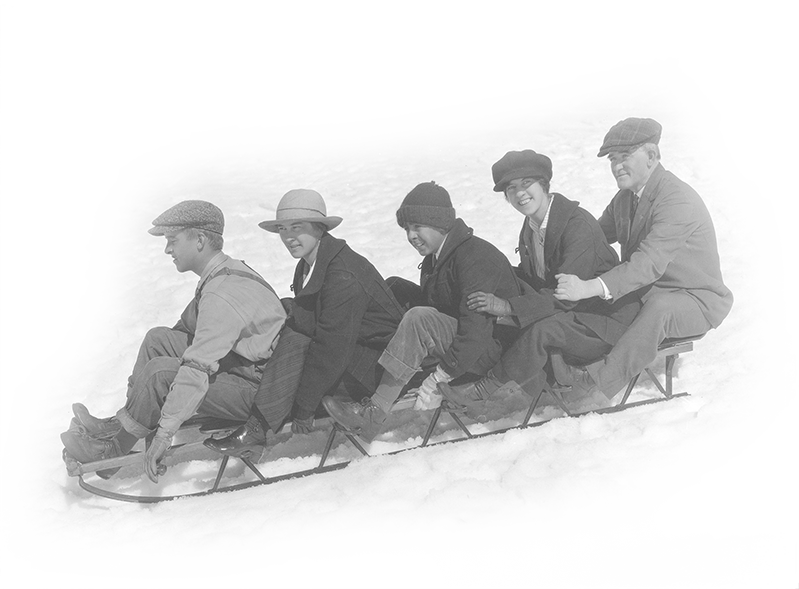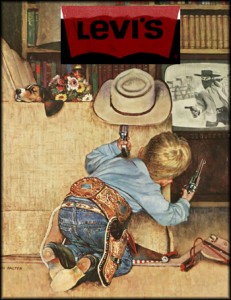 You might think that a “Levi” started Levi Strauss & Co., but such is not the case.
You might think that a “Levi” started Levi Strauss & Co., but such is not the case.
In 1847, a man named “Loeb” Strauss left Bavaria and sailed to New York with his mother and sister. His half-brothers were in a wholesale dry goods (cloth and linen bolts, clothing, etc.) business. In 1853, Loeb decided to take the hazardous trek to a bustling (because of the Gold Rush) San Francisco to seek a new start. Sometime around 1850, he reinvented more than just his location: he changed his name to “Levi.” We should all be grateful for this change:
If he hadn’t have taken that step, the world would be wearing “Loeb’s.”
There are some myths and ambiguity (due to the loss of records from the 1906 San Francisco earthquake and fire) surrounding how Levi actually started making his signature jeans. What is known is that a Nevada tailor, Jacob Davis, contacted Levi about becoming a business partner in his new venture: tough, riveted work clothing for miners in the Reno area. Levi realized the import of such an opportunity, and in 1873 Levi Strauss & Co. and Davis received a patent for an “Improvement in Fastening Pocket-Openings.” And you know the rest! Read the time-line below for exactly when everything happened.
Time-Line
19th Century
1829
– Levi Strauss is born in Buttenheim, Bavaria.
1847
– Levi Strauss, his two sisters and mother sail for America, where they join half-brothers Jonas and Louis in New York. Levi joins their dry goods business.
1853
– Levi becomes an American citizen and sails to San Francisco to set up a small dry-goods house, which grows into a prosperous business over the next twenty years.
1854
– Levi Strauss donates $5 to a San Francisco orphanage only one year after arriving in the city to open his dry-goods business. This is equivalent to approximately $110 U.S. and begins the company’s tradition of sharing its prosperity with the community.
1866
– LS&CO. headquarters are at 14-16 Battery Street, where they remain for 40 years.
1871
– Levi Strauss & Co. gives $100 to the Chicago Relief Fund to help rebuild after the fire of 1871.
1872
– Jacob Davis, a Reno Nevada tailor, writes to Levi Strauss & Co., telling him of the process he invented to rivet the pocket corners on men’s pants. He suggests the two men take out a patent on the process together.
1873
– Levi Strauss and Jacob Davis receive the patent for rivets on men’s pants. They begin making copper-riveted “waist overalls” (the old name for jeans) in San Francisco. The denim comes from the Amoskeag Mill in New Hampshire.
1897
– Levi Strauss donates funds to endow 28 scholarships at the University of California,Berkeley. These scholarships are still in place today.
1900~1919
1902
– Levi Strauss dies at the age of 73. His nephews inherit the business.
~Levi Strauss’ will contains a number of bequests to Bay Area charities which serve children and
the poor.
1906
– The earthquake and fire destroy the headquarters and two factories of Levi Strauss & Co. The company extends credit to its wholesale customers so they can get back on their feet and back in business. Employee salaries are continued, and temporary headquarters and a showroom are opened in order to keep employees working. A new factory is built at 250 Valencia Street, and new headquarters are erected on Battery Street.
1912
– Simon Davis, son of Jacob Davis and the superintendent of the Valencia Street factory,invents “Koveralls,” a one-piece play suit for children and the company’s first nationally distributed product.
1915
– L &CO. receives the Highest Award for waist overalls at the Panama Pacific International Exposition in San Francisco. The company begins to purchase denim from Cone Mills in North Carolina.
1919
– Walter A. Haas, Sr. joins the company
1920s
1920
– A factory is opened in Frankfort, Indiana to make Koveralls.
1920s
– During this decade, the assembly-line technique is adopted at the Valencia Street and Frankfort factories. In addition, the climate for selling denim products is unfavorable; the price of cotton drops sharply, rendering cotton garments subject to price reduction. Despite this, Walter Haas, Sr. maintains the company’s $25,000 advertising budget, as he feels advertising (in the form of billboards and painted signs) is crucial to the success of the waist overalls.
1926
– Bonuses are given to the workers at the Valencia Street factory, possibly a first in theapparel industry.
1928
– The company registers the word Levi’s® as a trademark.
1930s
1930s
– The Depression strikes and the demand for products declines. Workers at the Valencia Street facility are put on a short work week to avoid layoffs, and others are given non-manufacturing tasks such as laying the hardwood floors that are still in use today. At the same time, the company adopts the cowboy as its advertising and image-building icon, associating the rugged individualism of the cowboy (and his Hollywood counterpart) with the famous 501® waist overalls.
1934
– LS&CO. creates “Lady Levi’s®,” the company’s first blue jean for women.
1940s
1940s
– During World War II, the design of waist overalls is changed due to government
mandates regarding the conservation of raw materials. U.S. soldiers wear their Levi’s® jeans and jackets overseas, giving the products their first international exposure.
~African-American workers at the company’s California plants work in integrated facilities.
1948
– LS&CO. discontinues its wholesale business in order to concentrate on manufacturing apparel.
1950s
1952
– The Levi Strauss Foundation is formed to coordinate the company’s charitable giving.
1954
– “Lighter Blues” casual slacks and the “Denim Family” line mark the company’s entry intothe sportswear business.
~An Army colonel on an American base in Frankfurt, Germany, bans military wives from wearing blue jeans, saying it reflects poorly on the U.S.
1958
– Levi’s® jeans are chosen for the American Pavilion at the World’s Fair in Brussels.
1959
– Levi’s® jeans are exhibited at the “American Fashion Industries Presentation” in Moscow.
~The company begins exporting garments to Europe and appoints an Export Manager.
1960s
1960s
– LS&CO. opens its first southern plant. Located in Blackstone, Virginia, the company insists from its inception that the facility be integrated. This occurs before desegregation is mandated by federal law.
1961
– Clothing is exhibited in Paris by our French distributor.
1962
– LS&CO. receives President Kennedy’s “E” award for significant contributions to the United States export program.
1963
– Pre-shrunk Levi’s® jeans are introduced.
1964
– STA-PREST® slacks —the first wrinkle free products — are introduced. Levi’s® jeans become part of the permanent collections of the Smithsonian Institution.
1965
– Levi Strauss International and Levi Strauss Far East are established, beginning the
company’s expansion into Europe and Asia.
1966
– The company airs its first television commercial.
1967
– Levi’s® jeans are exhibited in Moscow, Prague and Warsaw.
~Rock groups such as The Jefferson Airplane and Paul Revere and the Raiders record radio commercials for the Stretch Levi’s® and White Levi’s® lines.
1968
– The Community Affairs department is established, formalizing the company’s
philanthropic efforts.
1969-1970
– LS&CO. introduces bell bottoms into its jeans line.
~LS&CO. renovates the Valencia Street plant and the surrounding areas, creating a community gathering place and contributing to the improvement of the community.
Peter Haas, Sr. becomes President.
1970s
1970s
– Corduroy and polyester pants are added to the Levi’s® range, reflecting the styles of thetimes.
~The first Community Involvement Teams are formed at the headquarters office.
1971
– LS&CO. becomes a public corporation, and includes a statement of its values in its prospectus.
~Levi Strauss Japan is established, marking the company’s first official entry into the Asianmarketplace.
1974
– Company headquarters move to a large office complex at Embarcadero Center in San Francisco.
1980s
1982
– The Levi Strauss Foundation makes its first matching gifts to the Kaposi Sarcoma Clinic at San Francisco General Hospital.
1984
– LS&CO. is the official outfitter of the U.S. Olympic Team and the Los Angeles Gamesstaff.
~The “501® Blues” television campaign is launched at the Olympic Games, leading to resurgence in sales of the 501® jeans.LS&CO. receives the Lawrence A. Wien Prize in Corporate Social Responsibility.
1985
– LS&CO. wins the Governor’s Committee Media/Advertising Award from the New York
~State Office of Advocates for the Disabled, for its positive portrayals of disabled people in the “501® Blues” television ads.
~LS&CO. completes the largest leveraged buyout in the apparel industry and the company becomes private again.
1986
– Dockers® Khakis are introduced in the United States. The company holds its first auction of celebrity-decorated denim jackets to benefit AIDS research and education at Barneys in New York.
1990s
1990
– LS&CO. receives the German Apparel Supplier of the Year award, the first non-German and the first jeans company to win the award.
1991
– “Project Change,” an initiative to fight institutional racism in LS&CO. communities, is launched.
~The first Original Levi’s Stores® are opened in the United States, in Columbus Ohio.
~LS&CO. develops the first known set of comprehensive standards for manufacturing and finishing contractors worldwide, dealing with wages, hours, working conditions, ethics and the environment.
~ Strauss North America is formed to better coordinate the strategies and needs of the business in Canada, the U.S. and Mexico.
1993
– Business Ethics magazine names LS&CO. as one of three companies to win its
“Excellence in Ethics” award.
~Due to positive changes in South Africa, LS&CO.’s South Africa Policy Group recommends that the company modify its policy to consider doing business in that country (if free, fair, non- racial elections have been held and a Government of National Unity has been installed).
1994
– Levi’s® Dockers® are introduced in Europe..
~Employees at the Customer Service Center in Canton, Miss., are honored by the White House and Congress for their volunteer work in support of children and families in the Jackson and Canton communities.
1995
– Dockers® Khakis, invented in Japan ten years earlier as Docker Pants, are re-introduced to Japanese consumers.
~LS&CO. places No. 1 among apparel firms and No. 16 overall in Fortune magazine’s annual list of America’s most admired corporations.
~Hispanic magazine names LS&CO. among the top 100 companies that provide the most
opportunities for Hispanic employees.
~LS&CO. launches its first site on the Web at www.levi.com.
~Levi Strauss Japan sponsors the Rolling Stones’ “Voodoo Lounge” tour.
~”Clayman” becomes LS&CO.’s first global commercial for the Levi’s® brand and runs in countries on all five continents.
1996
– Levi’s® Vintage Clothing is introduced globally. LVC is a line of authentic reproductions ofclothing from the Levi Strauss & Co. Archives.
~The Martin Luther King Jr. Center for Nonviolent Social Change presents LS&CO. with the 1996 Management Award. The Union of Needletrades, Industrial and Textile Employees (UNITE), which represents several LS&CO. owned-and-operated manufacturing facilities, made the award nomination in recognition of the unique partnership between LS&CO. and UNITE.
1997
– LS&CO. receives the Organizational Award for a Large Business from the Centers for Disease Control.
~The company also receives the Quality of Life Award from Auburn University.
1998
– LS&CO. celebrates the 125th anniversary of the invention of jeans.
~A flagship Original Levi’s Store® opens on San Francisco’s Union Square.
Present
2000
– LS&CO. introduces Levi’s® Engineered Jeans™, the reinvention of jeans for the 21st century. LS&CO. named No. 2 in Fortune’s “America’s Best Companies for Minorities”.
~Levi Strauss & Co. sponsors D’Angelo and Christina Aguilera concert tours.
2003
– Levi Strauss & Co. celebrates the 150th anniversary of its founding and the 130th
anniversary of the invention of blue jeans by Levi Strauss and Jacob Davis.
2004
– The Levi Strauss Foundation is presented with the Corporate Philanthropy Award by the Ms. Foundation. The theme of the awards is how community participation builds and strengthens democracy.
~Case studies involving LS&CO. and the Levi Strauss Foundation are featured in the book called Compassionate Capitalism: How Corporations Can Make Doing Good an Integral Part of Doing Well.
For more information, time-lines and facts, visit the Levi Strauss Co website.


